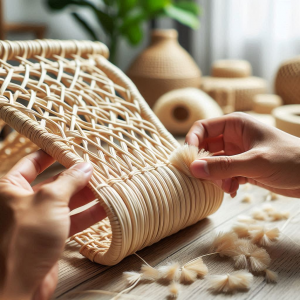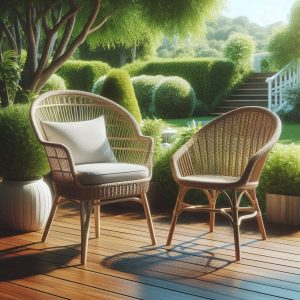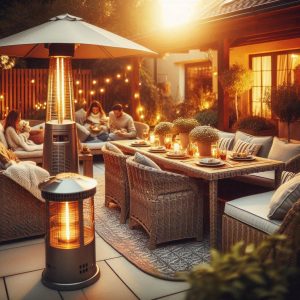
Rattan furniture is very much on trend now and is the ‘go-to’ choice for many home improvement professionals, as numerous articles in ‘Ideal Home’ and other glossies like ‘Homes and Gardens’ will testify. However, the reality of a British summer is often far away from those shiny website images. Finding outdoor rattan furniture that delivers style is not difficult, but what is a concern for many UK buyers is durability because of that old favourite, the British weather.
The problem with the UK climate is that it is just so unpredictable. Climatologists agree that UK summers are becoming hotter and drier, and that intense heat is building far more quickly. There is less rainfall, but when it comes, it is also more intense. Leaving your outdoor furniture outside at the ready risks exposing it to extreme UV and monsoon-style downpours.
Thankfully, this guide takes all the mystery out of rattan furniture. It offers expert advice on rattan types, styles, and designs and key tips on maintenance and furniture care so you can feel confident in choosing rattan for your outdoor space.
Understanding Rattan Furniture
What is Rattan?

Rattan is a long-stemmed vine that is woven into furniture. It is often used interchangeably with wicker, which is also a name for woven furniture, but not all wicker furniture is made from rattan.
Rattan can also be used to create furniture using the ‘caning’ technique, where thin strips of rattan peel or cane are woven to create a chair back or seat. This material is more delicate and is typically seen on interior period pieces from the mid-20th century.
Because rattan can be steamed, it can be sculpted into different shapes, producing architecturally pleasing curved pieces popular for use in the garden.
Rattan furniture is available in natural rattan, or a synthetic alternative known as Polyethylene rattan or PE rattan. Natural rattan is strong and has a sustainable environmental profile.
Natural rattan furniture looks sophisticated and is more pleasing to the touch than the synthetic alternative. However, natural rattan is vulnerable to the weather and suffers from prolonged heat or dampness, so it requires more care and maintenance.
Synthetic rattan, in contrast, is easy to care for and withstands outdoor life in the UK much better. However, it lacks the organic warmth of natural rattan, and the synthetic fibres are produced in a less environmentally friendly way.
Rattan Furniture in the UK
Rattan furniture was popular in the home throughout the early and mid-20th century, but then this material fell out of fashion. However, rattan has experienced a huge revival in popularity in the new millennium, particularly for outdoor furniture.
Rattan furniture looks good anywhere, whether on a modern apartment balcony or a classic terrace outside a period home. It has a timeless appeal and, depending on the style and colours you choose, offers just a hint of old colonial or a fresh and contemporary vibe.
However, given the variable and unpredictable nature of the UK climate, you would be right to have concerns about the durability of rattan as an outdoor furniture material.

The Impact of British Weather on Rattan Furniture
The UK Climate Overview
The UK climate has always delivered all four seasons in one day. However, with global warming, the variation and unpredictability of British weather are increasing.
Any outdoor furniture is particularly vulnerable to temperature extremes, and rattan is especially susceptible to UV rays; according to the UV Index, UV levels are increasing in the UK. However, the durability and appearance of rattan furniture are also affected by rain, humidity, and frost in the winter.
Durability of Rattan Furniture
The UK climate significantly impacts natural rattan furniture. Rain soaks into the plant fibres, which can develop mould. Strong and continuous sunlight fades the colour, making the fibres brittle, leading to warping, and making them more prone to breaking.
What you lose on feel and appearance with synthetic rattan, you certainly gain when it comes to durability and weather resistance. PE rattan doesn’t discolour or degrade nearly as quickly as natural rattan when exposed to sun, rain and extreme temperatures.
Weatherproofing Rattan Furniture
One of the simplest ways to protect rattan furniture against the temperamental UK climate is to cover it, but if you want to use the furniture regularly, taking covers on and off or moving the furniture indoors and then outside again is a real chore.
If you weatherproof your rattan furniture, you can leave it uncovered for most of the summer season. Weatherproofing is a straightforward process; it just means protecting your furniture from excess moisture and UV rays from the sun. However, before you start, you do need to know whether your furniture is natural or synthetic rattan, as the treatments differ.
All rattan needs to be cleaned to remove dust and debris before applying a protective sealant. Natural rattan furniture is usually lightly sanded after cleaning to prepare the plant’s surface to absorb the product. Yacht varnish or tung oil is recommended for natural rattan. Tung oil is extremely water resistant and minimises moisture penetrating the fibres.
Synthetic rattan is never sanded and can be treated with an appropriate product which protects against colour fade and deterioration.

Comparing Rattan to Other Outdoor Furniture Materials
Rattan vs Wicker
Rattan is undoubtedly high on the list for design and aesthetics, but rattan garden furniture will not perform well in the UK climate if left to its own devices, so you’ll need to be prepared to maintain and protect it.
Wicker is a technique rather than a material. Wicker furniture can be made of rattan, but there are also bamboo and synthetic options, usually vinyl. Outdoor synthetic wicker furniture is very durable and resists heat and moisture without cracking or fading, making it a more long-lasting option in a location prone to humidity.
Rattan vs. Plastic
Plastic outdoor furniture is lightweight, affordable, easily portable, low maintenance, and waterproof, so there are few drawbacks. Some plastic imitation wood options look like the real deal—plastic furniture has come a long way from those cheap deckchairs that always collapse.
Plastic furniture is excellent for high usage, such as for families with young children and is tougher than rattan. If you choose carefully, you can find plastic furniture with an excellent environmental profile and simple, green-friendly manufacturing processes. However, not all plastic furniture is made equal, so doing your homework is essential.
Plastic outdoor furniture is almost unbeatable as an alternative to wood, but it cannot compete with rattan, even synthetic rattan when it comes to aesthetics. Plastic furniture can be basic in appearance and doesn’t offer the high-end look of rattan or last as long.
Rattan vs. Metal
Metal outdoor furniture is tough and durable with a stylish design aesthetic, especially compared with plastic outdoor furniture. However, it will require some maintenance to stay looking its best, but it is usually easy and quick to keep clean.
Metal outdoor furniture may score well in the design stakes. Like rattan, it is certainly visually appealing, but substantial pieces like tables can be heavy to move around. If you like your furniture to be easily portable, there may be better choices than metal.
Metal outdoor furniture also relies on textiles to make it comfortable, and it can get very hot in the sun and unpleasant to touch.
Metal will eventually rust, so metal furniture requires a more serious overhaul every few years to keep it looking its best. This means rubbing down and re-painting, a much longer and more complicated job than caring for rattan furniture.
Practical Tips for Protecting and Maintaining Rattan Furniture

Regular Cleaning
Regularly cleaning rattan furniture preserves its life, maintains its colour and shape, and ensures it is ready for use when you want it.
Preventing dirt build-up is easy. Use a soft brush or vacuum on a low setting to remove dirt particles and other debris. An old toothbrush can help loosen dirt in corners and hard-to-access areas.
After sweeping or vacuuming, wash the furniture with a very dilute solution of warm, soapy water. Use only a mild detergent.
Don’t soak natural rattan; just use the foam from the water on a cloth. Saturating the rattan fibres will only encourage mould particles to form. You can also use a garden hose on a low setting. If you have synthetic rattan, it will withstand a quick blast from a pressure washer.
Ensure the furniture dries thoroughly in a well-ventilated area.
Seasonal Care Tips
Plan to store your rattan furniture during winter when you don’t use it; you’ll need a ventilated and damp-free space. Clean it thoroughly before you store it and treat the rattan for weatherproofing with a proprietary product, depending on whether you have natural or synthetic rattan furniture.
It’s not always possible to protect rattan furniture from the summer sunshine; that’s the point of having it. However, if you aren’t using the furniture, moving it into the shade during prolonged heat will pay dividends to protect the rattan from the damaging effect of UV rays.
Covers are a quick and easy way to protect rattan furniture you’re not using.
Choosing the Right Covers
Covers are one of the best and easiest ways to protect outdoor rattan furniture from the harsh effects of rain and sun. If covers are available when you purchase your rattan furniture, they are a worthwhile investment, as they will be designed to fit your furniture.
Choose high-quality, water-resistant, and breathable covers to prevent condensation build-up, which can lead to mould. Never cover the furniture when it is wet.
Choosing the Right Rattan Furniture for Your Outdoor Space

Considerations for Small Spaces
Even if you don’t have much outdoor space, stylish rattan furniture is still an option; like all small spaces, you need to choose the right size and shape of outdoor furniture to make it work.
Cube sets work well in small areas like an enclosed patio or balcony. The rule of thumb is a metre of space around the table for chairs; otherwise, people will struggle to sit down and get up.
Bistro sets are designed for compact areas. They are scaled-down versions of traditional garden furniture and usually include a coffee table and two armchairs. Rattan bistro sets are aimed at either dining or lounging, and there are also foldable bistro sets to help you make the most of a small multi-use area.
Factors for Larger Gardens
Rattan outdoor furniture makes the perfect statement for stylish alfresco dining with designs and colour choices to suit every outside space. Create a hallmark dining area for entertaining or a cosy corner tucked away for privacy and relaxation.
Modular sets provide the ultimate outdoor lounging, with seating, long chaise pieces, and corner units that can be transformed into various configurations to suit different areas of your garden or various occasions.
Budget-Friendly Options
Synthetic rattan will always be cheaper than natural rattan, and it combines durability, ease of maintenance, and value.
However, if you’ve set your heart on natural rattan, then this doesn’t have to mean big price tags. Shopping around and taking advantage of special offers could bag you a bargain. ‘Best Buy’ guides can save you a lot of legwork, and rattan is always a popular topic for leading lifestyle magazines.
Because outdoor rattan furniture is mainly seasonal, plenty of retailers offer discounts and clearance deals as we head into autumn.
Case Studies and Real-Life Examples
Success Stories
You can’t get a better endorsement for the style and durability of outdoor rattan furniture than the blog from www.eventhireuk.com. They rate their modular sets, which are perfect for all sorts of occasions, with the flexibility to create different layouts and the durability to survive repeated event hire even in the unpredictable UK climate.
There is an interesting thread in a forum on Martin Lewis’s website, the money-saving and value guru. This thread has some valuable contributions from rattan furniture users in response to the question, “Can you leave rattan furniture outside all year?”
The conclusion seems to be that it’s not ideal and should be avoided, but that rattan furniture can live in the UK climate if you take care of it and maintain it properly.
Challenges Faced
One of the challenges raised by the Martin Lewis forum is mould. The UK climate is famous for dampness, but mould is usually a problem where there is a lack of ventilation. The moral is that if you can’t store rattan furniture in a cool, dry, well-ventilated space, you are better off cleaning it, treating it, and leaving it outside in a sheltered location.

Conclusion
Whatever outdoor space you have, rattan furniture will add style and elegance to your garden, terrace or balcony. As a home improvement, scaling up your space for socialising, relaxing or al fresco dining, rattan outdoor furniture is always a surefire success and at a relatively modest price.
Rattan garden sets come in various sizes, colours, styles, and budgets, so there is something for everybody. The key with rattan is to choose a type that suits your climate and the desired location, so it stays looking good for longer.
Maintenance and care will pay dividends, but if you’re short on time or energy, synthetic rattan, which is weather-resistant, will match your lifestyle. Armed with the proper knowledge now, caring for rattan is relatively straightforward, even if you only do it before you store the furniture for the winter.
Rattan furniture has never been more popular in UK gardens. It gives an ordinary outdoor space a ‘coffee culture’, luxury feel. Our website has different rattan garden furniture sets and numerous design ideas with complementary products like garden heaters, which will help you enjoy your outdoor furniture for longer.
Browse our extensive range of rattan furniture and garden accessories. Our unbeatable prices are not just the only attraction; our comprehensive blog and advice guides are packed with good ideas and handy hints. Now, those dreams for your outside space really can become a reality.

